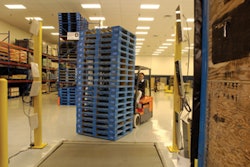Atlanta — June 7, 2007 — While the potential for companies to reduce costs by offshoring back-office operations is dramatic, companies can potentially increase these savings by over 50 percent by selectively integrating transformation and process improvement efforts into their globalization initiatives, according to new research from business advisory firm The Hackett Group.
According to Hackett's research, the Fortune 500 could generate over $91 billion annually, or about $182 million on average per company, by strategically combining "lift and shift" efforts, which move back-office processes overseas without first improving them, with "transform and shift" initiatives, where processes are optimized and then taken offshore.
Hackett's research finds that the key to generating these savings is careful planning and analysis to determine which processes to offshore and whether or not to integrate transformation, and a staged approach to offshoring over a five- to ten-year period. In some cases, Hackett's research shows that the potential exists for companies to capture the majority of the available cost reduction through process optimization alone.
Comparing Strategies
"As offshoring has matured as a business strategy over the past few years, the discussion has shifted, from 'should we?' to 'how should we?'" said Hackett Chief Research Officer Michel Janssen. "But it's a complex, long-term process, with the potential for spectacular successes as well as real failure that can cause companies significant setbacks. Companies that try to take the easy way out and rely solely on a simple 'lift and shift' approach, will significantly increase their risk and are likely to capture only a fraction of the value that's out there."
According to Hackett Senior Business Advisor Julio Ramirez: "Each of the three approaches we've outlined in our research has advantages and disadvantages that vary based on the processes being considered for offshoring and the profile of the company involved. By analyzing our benchmark data for more than 30 back-office processes, we've developed some strong guidance for companies that want make the most of this exceptional opportunity."
Hackett's analysis calculates the following assessment of the potential cost reductions available to the Fortune 500, in total, through each of three approaches: "lift and shift," "transform and shift," and transformation alone. The analysis is based on wage rate savings available in typical offshore geographies and incorporates an assessment of the expected percentage of headcount that would be involved in each functional area. These assessments are based on detailed process data from Hackett's database of back-office benchmarks.
Assessing Processes, Risk and Value
Hackett recommends that companies analyze multiple factors as they evaluate their globalization and transformation decisions, including the current performance levels of each process, the risk of transformation and globalization, the complexity of the process and the net present value of the strategic alternatives.
In examining process complexity, Hackett suggests that companies look well below the functional level, at individual processes and the learning curve required to become proficient at them. The longer the learning curve, the more likely the process will benefit from transformation prior to offshoring.
In its evaluation, Hackett emphasizes that risk should not be an excuse for avoiding globalization. But mitigation strategies should be considered based on the risk assessment and the risk tolerance of the organization. Finally, in determining net present value of globalization efforts, Hackett recommends that companies look beyond labor arbitrage to construct a business case that assesses implementation costs, additional management overhead and also the potential upside of globalization.
Globalization — A Series of Waves
The speed at which globalization is implemented will vary from company to company. Hackett suggests that most relatively healthy companies would be well advised to organize their back-office globalization efforts in waves and plan to execute these waves over a five- to ten-year timeframe designed to maximize long-term shareholder value. But companies facing intense global pressures related to pricing, markets or competition may need to move faster, increasing risk and potentially reducing long-term gains in order to generate savings critical to their short-term viability.
Following their initial analysis, many companies will target processes offering the largest financial opportunities. But Hackett finds that this approach significantly increases risk, and the consultants recommend instead that companies begin Wave 1 with low-risk transactional processes that can be offshored using the "lift and shift" approach.
Once a company has established its ability to move processes offshore, it can proceed to Wave 2 of its globalization efforts, which involves offshoring processes that carry more risk. This wave is much more complex and challenging, as it generally requires transformation and often includes processes executed by fractionalized employees and/or staff dispersed between different portions of the company.
Wave 2 requires companies to take a "transform and shift" approach to identify where processes are currently taking place, to redesign, document and automate these processes, and also to focus on issues such as risk assessment and mitigation, knowledge transfer and employee training. A significant number of employees' roles are also likely to change, requiring that their job specification be adjusted.
Finally, in Wave 3 of their globalization efforts, companies can address activities that are highly complex and/or directly touch the customer. Challenges in this wave may include disentangling processes from their current environment, more significant training, longer learning curves and extensive change management processes.
According to Hackett's research, the Fortune 500 could generate over $91 billion annually, or about $182 million on average per company, by strategically combining "lift and shift" efforts, which move back-office processes overseas without first improving them, with "transform and shift" initiatives, where processes are optimized and then taken offshore.
Hackett's research finds that the key to generating these savings is careful planning and analysis to determine which processes to offshore and whether or not to integrate transformation, and a staged approach to offshoring over a five- to ten-year period. In some cases, Hackett's research shows that the potential exists for companies to capture the majority of the available cost reduction through process optimization alone.
Comparing Strategies
"As offshoring has matured as a business strategy over the past few years, the discussion has shifted, from 'should we?' to 'how should we?'" said Hackett Chief Research Officer Michel Janssen. "But it's a complex, long-term process, with the potential for spectacular successes as well as real failure that can cause companies significant setbacks. Companies that try to take the easy way out and rely solely on a simple 'lift and shift' approach, will significantly increase their risk and are likely to capture only a fraction of the value that's out there."
According to Hackett Senior Business Advisor Julio Ramirez: "Each of the three approaches we've outlined in our research has advantages and disadvantages that vary based on the processes being considered for offshoring and the profile of the company involved. By analyzing our benchmark data for more than 30 back-office processes, we've developed some strong guidance for companies that want make the most of this exceptional opportunity."
Hackett's analysis calculates the following assessment of the potential cost reductions available to the Fortune 500, in total, through each of three approaches: "lift and shift," "transform and shift," and transformation alone. The analysis is based on wage rate savings available in typical offshore geographies and incorporates an assessment of the expected percentage of headcount that would be involved in each functional area. These assessments are based on detailed process data from Hackett's database of back-office benchmarks.

Assessing Processes, Risk and Value
Hackett recommends that companies analyze multiple factors as they evaluate their globalization and transformation decisions, including the current performance levels of each process, the risk of transformation and globalization, the complexity of the process and the net present value of the strategic alternatives.
In examining process complexity, Hackett suggests that companies look well below the functional level, at individual processes and the learning curve required to become proficient at them. The longer the learning curve, the more likely the process will benefit from transformation prior to offshoring.
In its evaluation, Hackett emphasizes that risk should not be an excuse for avoiding globalization. But mitigation strategies should be considered based on the risk assessment and the risk tolerance of the organization. Finally, in determining net present value of globalization efforts, Hackett recommends that companies look beyond labor arbitrage to construct a business case that assesses implementation costs, additional management overhead and also the potential upside of globalization.
Globalization — A Series of Waves
The speed at which globalization is implemented will vary from company to company. Hackett suggests that most relatively healthy companies would be well advised to organize their back-office globalization efforts in waves and plan to execute these waves over a five- to ten-year timeframe designed to maximize long-term shareholder value. But companies facing intense global pressures related to pricing, markets or competition may need to move faster, increasing risk and potentially reducing long-term gains in order to generate savings critical to their short-term viability.
Following their initial analysis, many companies will target processes offering the largest financial opportunities. But Hackett finds that this approach significantly increases risk, and the consultants recommend instead that companies begin Wave 1 with low-risk transactional processes that can be offshored using the "lift and shift" approach.
Once a company has established its ability to move processes offshore, it can proceed to Wave 2 of its globalization efforts, which involves offshoring processes that carry more risk. This wave is much more complex and challenging, as it generally requires transformation and often includes processes executed by fractionalized employees and/or staff dispersed between different portions of the company.
Wave 2 requires companies to take a "transform and shift" approach to identify where processes are currently taking place, to redesign, document and automate these processes, and also to focus on issues such as risk assessment and mitigation, knowledge transfer and employee training. A significant number of employees' roles are also likely to change, requiring that their job specification be adjusted.
Finally, in Wave 3 of their globalization efforts, companies can address activities that are highly complex and/or directly touch the customer. Challenges in this wave may include disentangling processes from their current environment, more significant training, longer learning curves and extensive change management processes.









